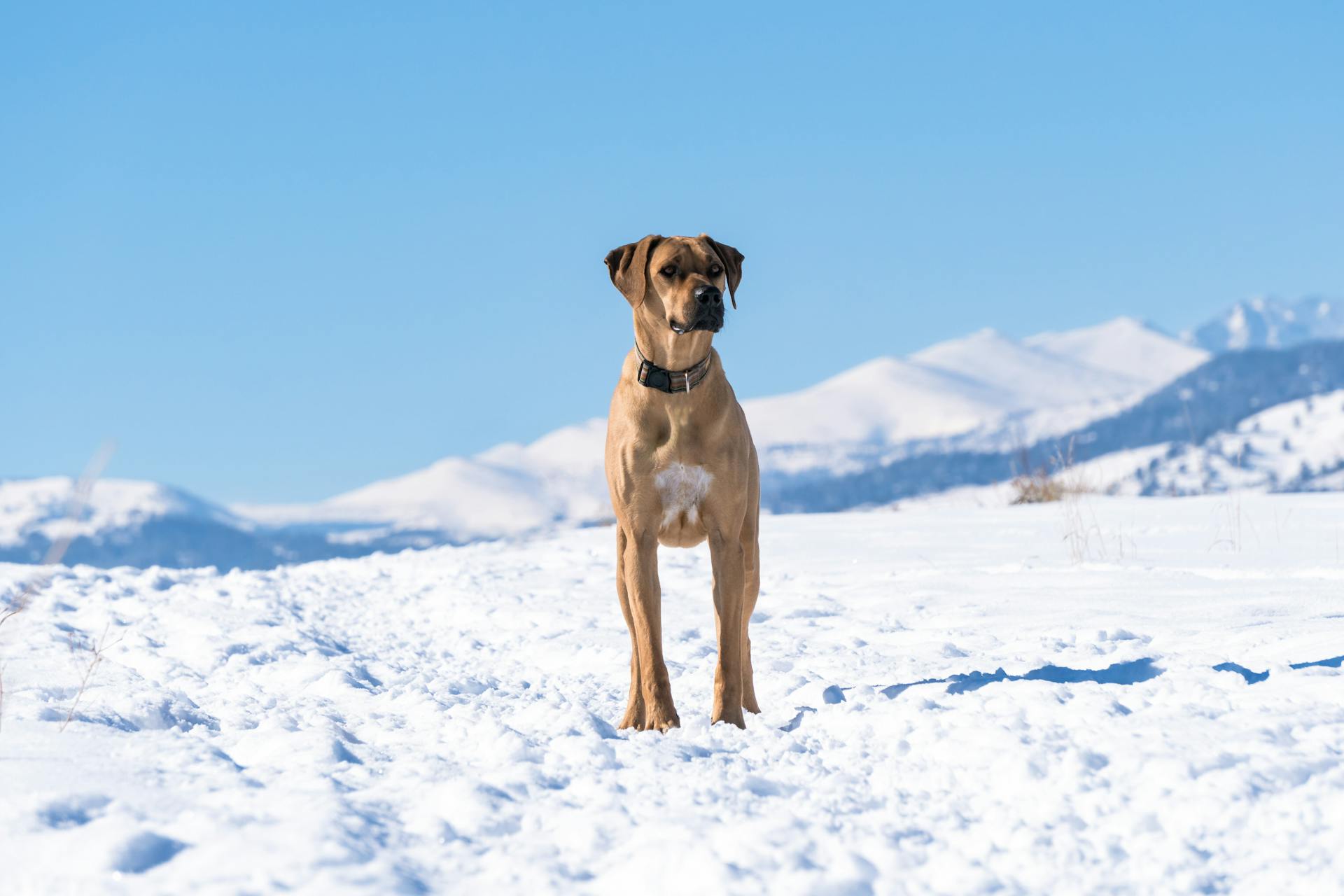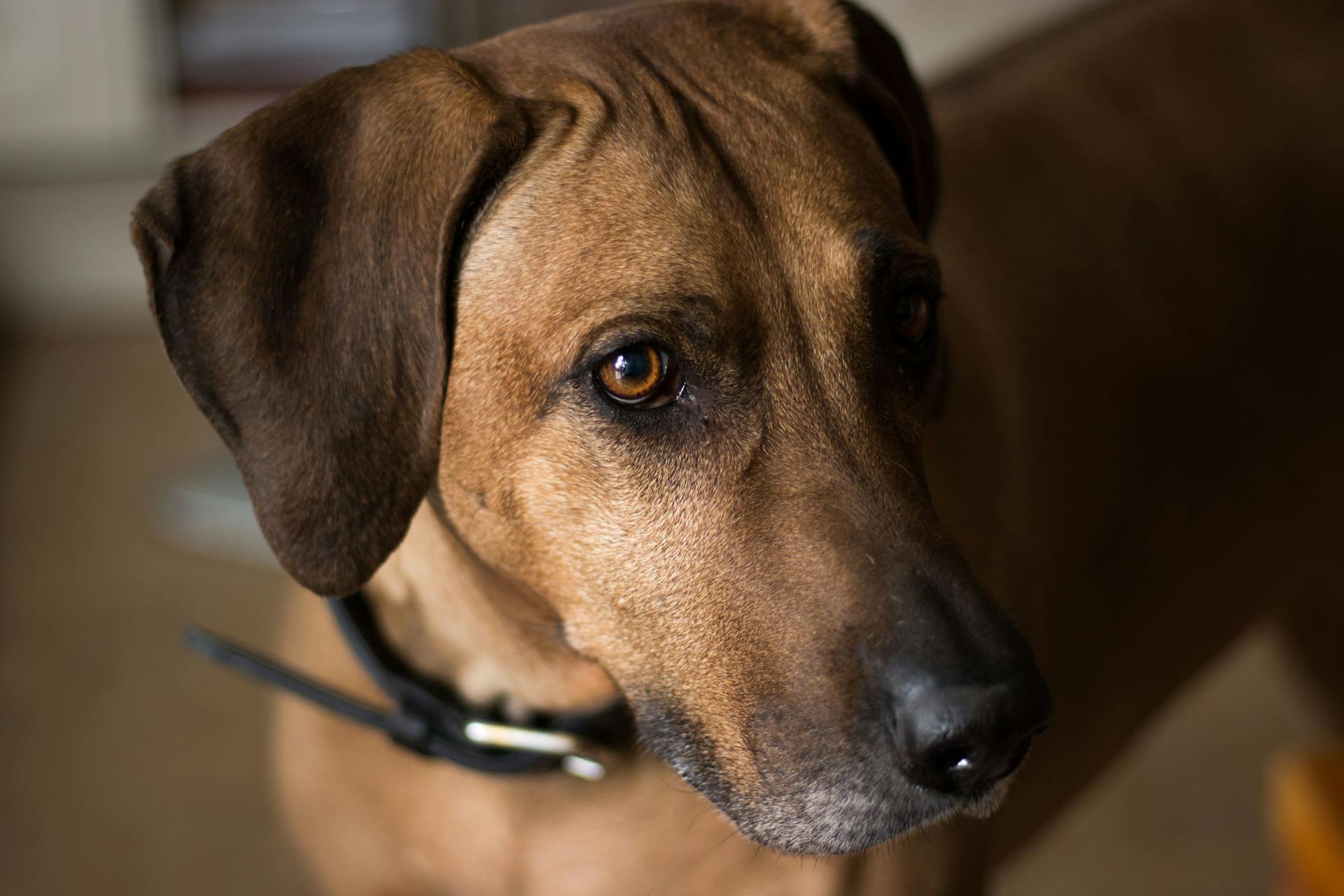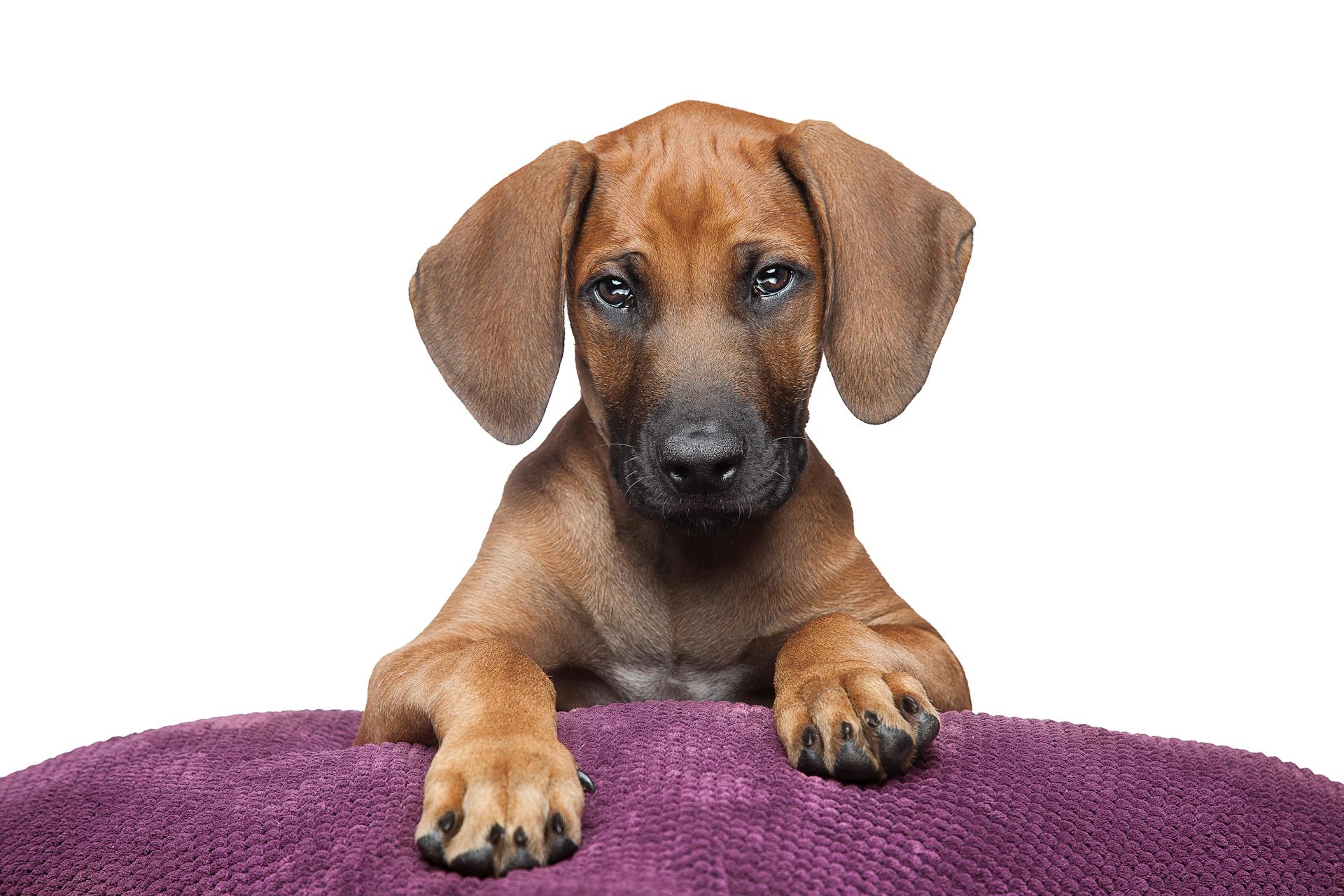
Rhodesian Ridgebacks are naturally protective of their families, but they can be wary of strangers, making socialization crucial from an early age.
They require regular exercise to stay happy and healthy, at least 30 minutes of physical activity daily, which can be a combination of walks, runs, and playtime.
These dogs are intelligent and trainable, but they can be stubborn at times, requiring patient and consistent training methods.
A consistent routine and positive reinforcement can go a long way in building a strong bond with your Rhodesian Ridgeback.
Learning Is a Building Block
Learning is a building block for your Rhodesian Ridgeback, just like it is for children. Each new technique learned builds on a previously learned behavior, making it essential to start with simple commands.
This incremental learning process is crucial for Rhodesian Ridgebacks, as they can be stubborn and dominant if not properly guided from a young age. Start with basic obedience training and gradually move on to more complex commands.
Explore further: When to Start Training Puppies
As you train your Rhodesian Ridgeback, remember that they don't learn instantly. You may need to repeat training frequently at first, but with patience and consistency, they'll pick up the new skills in no time.
Here's a breakdown of how to structure your training sessions to maximize learning:
By following this building block approach, you'll be well on your way to raising a well-behaved and sociable Rhodesian Ridgeback that's a joy to be around.
Training Tips
Training your Rhodesian Ridgeback requires patience, consistency, and positive reinforcement techniques.
Rhodesian Ridgebacks are intelligent and independent thinkers, which can make training a bit challenging. However, with the right approach, they can be successfully trained.
To start, focus on social behaviors and toilet training, as these should be the first things you teach your Rhodesian Ridgeback. These include behaviors such as not jumping up, sit, stay, heel, going to a location on demand, and staying away from places like the dinner table.
Combining verbal and physical actions within training will get the best results. For example, if you want your puppy to sit, simply give the command, push your puppy's bottom to the floor, smile, praise, and reward.
Socialization is also crucial, as Rhodesian Ridgebacks can be aloof and standoffish with strangers. Introduce them to as many people as you can and other animals to avoid this.
Here are some specific considerations for training Rhodesian Ridgebacks:
- Obedience training: Getting a handle on basic skills like "sit", "stay", and "wait" will be your friends over the years.
- Impulse control: Teaching commands like "leave it" can be particularly useful.
- Avoid punishment: Rhodesian Ridgebacks are smart, and can become very in-tune with human emotions. Control your temper during training, and reward the behaviors you want.
Remember, patience is key with a Rhodesian Ridgeback. Even with all the training in the world, your dog is going to follow their instincts sometimes. Do everything you can to keep them safe by walking them on a leash and making sure your yard is properly fenced.
Food is a very powerful motivator for the Rhodesian Ridgeback, so take advantage of tools like treats to reinforce good behavior.
A well-trained Rhodesian Ridgeback can strengthen the bond between owner and dog, help communication skills grow between owner and dog, and be fun for both the dog and the family.
Dog Care
The Rhodesian Ridgeback is a relatively low-maintenance dog when it comes to their diet. They do well on high-quality dog food, whether commercially manufactured or home-prepared with your veterinarian's supervision and approval.
Their diet should be appropriate to the dog's age, whether it's a puppy, adult, or senior. It's essential to watch their calorie consumption and weight level to avoid getting overweight. In fact, Ridgebacks are notorious "counter surfers", so be sure not to leave human food unattended.
Treats can be an essential aid in training, but giving too many can cause obesity. It's crucial to learn about which human foods are safe for dogs and which are not. Clean, fresh water should always be available to your Ridgeback.
Here's an interesting read: Best Dog Food for Rhodesian Ridgeback
Remember You Chose a Dog!
You chose a Rhodesian Ridgeback for a reason, and it's essential to remember that. They're a faithful, affectionate, fun, easygoing, and athletic breed, but they're also stubborn and independent.
Rhodesian Ridgebacks aren't the easiest breed to train, so you need to be prepared to put in the work. With patience, consistency, and positive reinforcement techniques, they can be successfully trained.
Training your Rhodesian Ridgeback can be a challenge, but it's worth it. By starting training and socialization early, you can prevent behavioral issues and strengthen the bond between you and your dog.
Here are some essential training tips to keep in mind:
- Obedience training is crucial for Rhodesian Ridgebacks.
- Basic commands, such as "sit" and "stay", are essential.
- Early exposure to various environments helps prevent dominance and stubbornness.
- Keep training sessions interesting and fun to maintain your dog's focus and motivation.
- Positive reinforcement, such as treats, praise, and play, works best with this breed.
Remember, every dog is unique, but Rhodesian Ridgebacks require a special approach. With the right training and socialization, you can help your dog become a well-behaved and sociable companion.
Care
Taking care of your Rhodesian Ridgeback's diet is crucial for their overall health and well-being. A high-quality dog food, whether commercially manufactured or home-prepared with your veterinarian's supervision, is essential.
Feed your Ridgeback a balanced and nutritious diet suitable for their age, size, and activity level. This will help prevent weight gain and related health issues.
It's also important to limit treats and snacks to no more than 10% of their daily calorie intake. This will prevent overfeeding and keep your dog's weight in check.
Ridgebacks are notorious "counter surfers", so make sure to keep human food out of reach. Some dogs are prone to getting overweight, so monitor their calorie consumption and weight level closely.
A fresh-food plan can make it easy to feed the right amount for your dog's age, size, and activity level. This will help maintain a healthy weight, which is key to keeping joints healthy and improving overall health and quality of life.
Here are some general feeding guidelines for Rhodesian Ridgebacks:
- Puppies require a specially formulated large breed puppy food that supports their growth and development.
- Feed puppies 3-4 times a day until 6 months old, then reduce to twice daily.
- Follow the feeding guidelines provided by the food manufacturer and consult with your vet for specific dietary recommendations.
Rhodesian Ridgeback Facts
Rhodesian ridgebacks are large-breed dogs with a muscular build, originally developed in Southern Africa.
They typically weigh between 70 and 85 pounds and stand an average of 24 to 27 inches tall.
The breed comes in one color, wheaten, which ranges from pale brown to deep reddish brown.
Their short, glossy coats are uniform in length over the entire body, except for the trademark ridge of backwards-growing fur along their spines.
Rhodesian ridgebacks are known for their affectionate and fiercely loyal nature, making them great family dogs.
Basic Breed Facts
The Rhodesian ridgeback is a large-breed dog with a muscular build. Originally developed in Southern Africa, this breed is a nod to its African origins.
Mature Rhodesian ridgebacks typically weigh between 70 and 85 pounds. They stand an average of 24 to 27 inches tall.
This breed comes in one color, wheaten, which ranges from pale brown to deep reddish brown. Their short, glossy coats are uniform in length over the entire body.
The Rhodesian ridgeback's most distinctive physical feature is the ridge of fur in the middle of its back. The ridge is a trademark of the breed.
What Are They?
The Rhodesian Ridgeback is a remarkable dog breed with a rich history. They originated from southern Africa, bred by the indigenous Khoikhoi and San tribes.
Their ancestors were semi-domesticated hunting dogs kept by the Khoikhoi people, a nomadic tribe indigenous to South Africa. These dogs were described by Dutch traders as fearless guardians.
One of their distinctive features is the ridge of hair along their back that grows in the opposite direction to the rest of their coat, hence their name. This unique feature has been passed down through generations.
Rhodesian Ridgebacks were originally bred to track and hold lions until the hunters arrived. They were also developed to be versatile hunting dogs capable of tracking and guarding.
On average, males stand at 63-69 cm tall, while females stand at 61-66 cm. They weigh between 29 to 41 kg.
Their lifespan is approximately 10 to 12 years.
Rhodesian Ridgeback Temperament
Rhodesian Ridgebacks possess a calm and confident temperament.
Early socialisation is crucial to help them develop proper behaviour and be more comfortable around new people and animals.
They are known for their loyalty and affection towards their families, but can be reserved with strangers.
Ridgebacks have a strong protective instinct, making them excellent watchdogs.
Here are some key personality traits to keep in mind:
They can get along with other dogs or cats, especially when they're raised together from a young age, but exercise caution when introducing them to unfamiliar animals.
Ridgebacks have a high prey drive, so they should be kept on-leash in open areas to prevent them from chasing after sights or smells that catch their attention.
Take a look at this: When Can You Mate a Female Dog
Rhodesian Ridgeback Health
Rhodesian ridgebacks typically live 10 to 12 years, but certain health concerns can impact their lifespan and quality of life.
Dermoid sinus is a common inherited health problem in Rhodesian ridgebacks, often found on the neck, back, or upper spine, and can be treated surgically.
Regular vet visits are crucial to stay on top of any dog's health, especially for Rhodesian ridgebacks prone to joint issues like hip and elbow dysplasia.
Weight maintenance is key in preventing joint issues in Ridgebacks, so be sure to feed them a balanced diet and only give them an appropriate amount of exercise as they grow.
If you're getting a puppy, make sure their parents have been screened for common issues like dermoid sinus and hypothyroidism.
Are Healthy?
Rhodesian Ridgebacks are generally a healthy breed, but like any other, they may be prone to certain health conditions.
Hip dysplasia is a common issue in many breeds, and Rhodesian Ridgebacks are no exception. They can also be prone to elbow dysplasia.
Being aware of these conditions can help you detect any potential problems and seek timely veterinary care. Regular check-ups with your veterinarian can help identify any issues early on.
Hip dysplasia can lead to arthritis and mobility problems if left untreated.
Consider reading: Hip Dysplasia Bernese Mountain Dog
Common Health Concerns
Rhodesian ridgebacks are generally a healthy breed, but they can be prone to certain health concerns that affect their lifespan and quality of life. They typically live between 10 to 12 years.
Dermoid sinus is a common inherited health problem in Rhodesian ridgebacks, also known as pilonidal sinus. It's a tube-like opening in the skin that develops as a birth defect, often found on the neck, back, or upper spine.
Joint dysplasia is a condition that can cause chronic pain and arthritis, especially in large and active breeds like the Rhodesian ridgeback. Weight maintenance is crucial in preventing joint issues, so be sure to feed your Ridgeback a proper diet and monitor their exercise.
Food allergies or sensitivities are another common issue in Rhodesian ridgebacks, often triggered by specific proteins in their food. Switching to a high-quality diet free from the allergenic ingredient can help resolve symptoms like atopic dermatitis, or itchy skin.
Hypothyroidism is a condition where the thyroid gland doesn't produce enough thyroid hormone, leading to skin problems, low energy levels, and weight gain. Regular vet visits can help you stay on top of your dog's health and catch any potential issues early on.
Frequently Asked Questions
What age do Rhodesian Ridgebacks calm down?
Rhodesian Ridgebacks typically calm down by the time they are two years old. Consistent training and patience are key to helping them settle down during this period.
How long should I walk my Rhodesian Ridgeback puppy?
Your Rhodesian Ridgeback puppy needs at least two hours of exercise daily, including several long walks and off-lead playtime in a secure area
Sources
- https://www.thepetsandlove.com/how-to-properly-train-your-rhodesian-ridgeback-10-most-effective-tips/
- https://www.akc.org/dog-breeds/rhodesian-ridgeback/
- https://www.borrowmydoggy.com/doggypedia/dog-breed-guides-rhodesian-ridgeback
- https://www.thefarmersdog.com/digest/rhodesian-ridgeback-breed-guide-history-personality-training-health-and-feeding/
- https://alaskadogworks.com/how-to-train-a-rhodesian-ridgeback/
Featured Images: pexels.com

